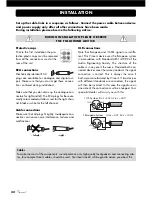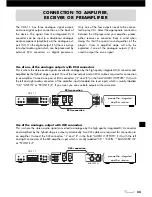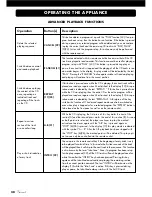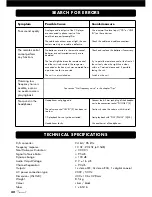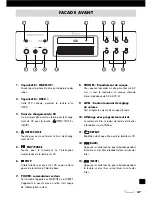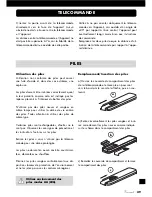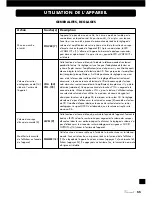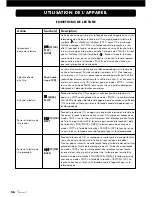
Vincent
43
GLOSSARY
Audio Sources/Source devices
These are the components of your HiFi system and
all other appliances, whose sound you want to hear
over the system and are thus connected to the pre-
amplifier, amplifier or receiver. This includes CD
players, DVD players, tuners (radios), cassette play-
ers, DAT recorders, personal computers, record play-
ers, portable audio devices and many more.
Dynamic
The volume difference between the quietest and
the loudest sounds possible in audio signals (wit-
hout distortion or transition to noise).
Input sensitivity
Term for the smallest average (RMS) input voltage
which causes the maximum output power at the
maximum volume setting on the amplifier.
Examples: 100 mV to 500 mV (Millivolts) on high
level inputs, 2 mV to 5 mV on the phono MM input
or 0.1 mV to 0.5 mV on the phono MC input.
HDCD
(High Definition Compatible Digital)
Listening tests showed that an increase in the reso-
lution of digital CD recordings starting from 16
bits represents improvements in sound. HDCD is a
recording/playback process for standards CD’s
with a sampling depth of 20 bits and data com-
pression. In this patented procedure the sound
material is recorded at a 20-bit sampling resoluti-
on. The sound quality compared with standard
Audio-CD’s is improved as a result. These discs
labelled HDCD are downward-compatible to stan-
dard players, but can only be played to their full
quality in special players. HDCD-signalling is sto-
red in the lower value bits of the conventional
sound sample, which represents inaudible alterati-
ons there. Only very few CD titles are obtainable
in this extended format.
dB-Level
This is a way of describing any physical quantity;
it is a common measurement for signal voltages
and the volume. It is given in decibels (dB). Al-
ternating signal voltages below 1V (RMS) are des-
cribed as "line level" voltages, which are suitable
as music signals for amplifier inputs. Inputs on
amplifiers (mostly represented by RCA sockets),
which are designed for signals on the CD player,
tape recorder, DVD player etc. are also referred to
as "line level inputs" or "high-level inputs". Those
signal inputs must not be confused with inputs that
accept preamplified signals.
RCA
RCA is the American name for coaxial RCA connec-
tors and sockets, originally the abbreviation for
"Radio Corporation of America", the name of a
United States company. Both the plug and cable
consist of a rod-shaped inner lead and a cylindrical-
shaped outer lead. This enables a mono audio
signal or a video signal to be transmitted. Com-
pared to the XLR plug connector, this type of connec-
tion is also called "unbalanced signal connection".
XLR
Also: "Symmetrical Connection" or "balanced".
A plug-and-socket connection for audio devices.
It is round (with approx. 1.5 cm in diameter) and
has 3 contacts/pins. XLR is an alternative connec-
tion to RCA used to transmit NF-Signals in profes-
sional audio equipment. The advantage is one
additional transmission path for the same but
phase inverted signal. If the receiving device can
process this, all inducted noise received in the
cable screen can be eliminated. The signal volta-
ge level used for this type of transfer is higher, so
it is a more robust less sensitive signal path.
Summary of Contents for CD-S1.1
Page 10: ...10 Vincent TASTEN DER FERNBEDIENUNG 20 18 28 21 23 24 26 27 19 30 31 22 33 32 34 25 35 29...
Page 30: ...30 Vincent BUTTONS OF THE REMOTE CONTROL 20 18 28 21 23 24 26 27 19 30 31 22 33 32 34 25 35 29...
Page 50: ...50 Vincent TOUCHES DE LA TELECOMMANDE 20 18 28 21 23 24 26 27 19 30 31 22 33 32 34 25 35 29...




